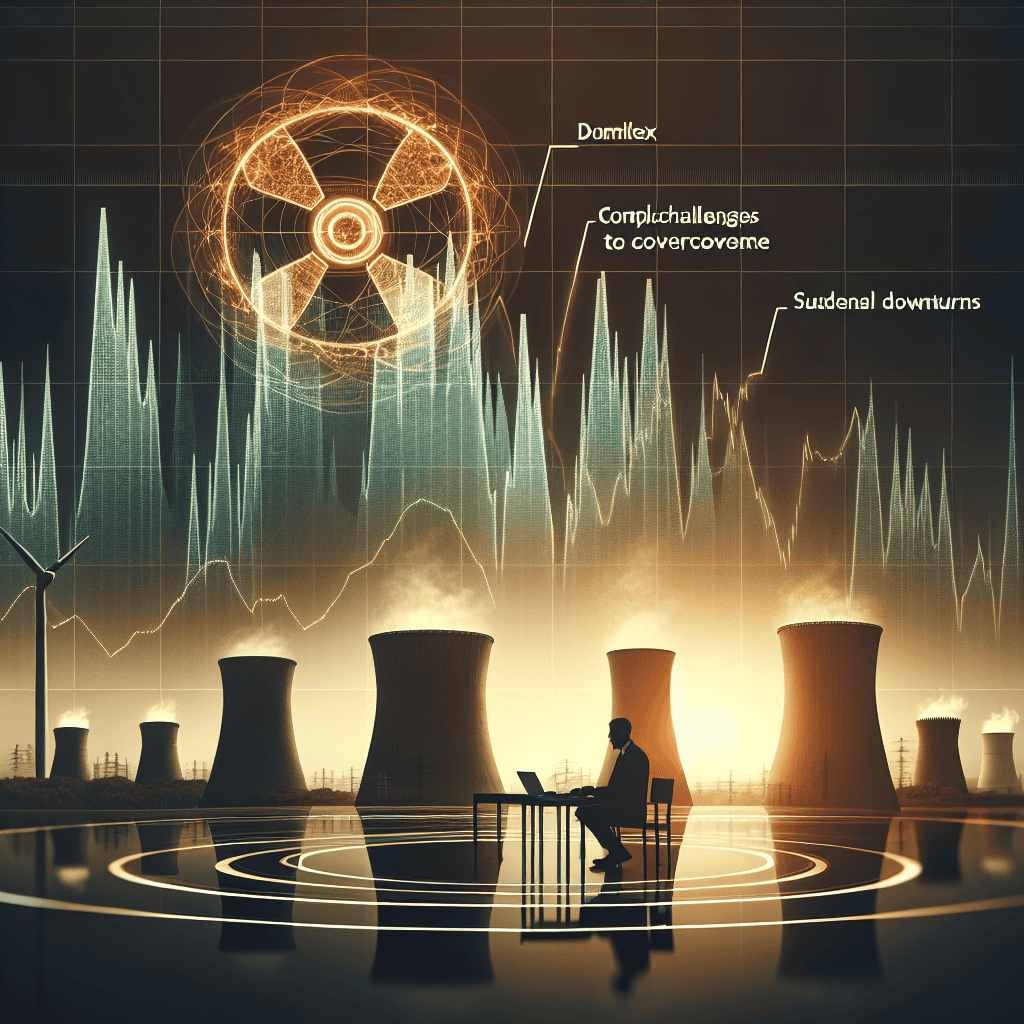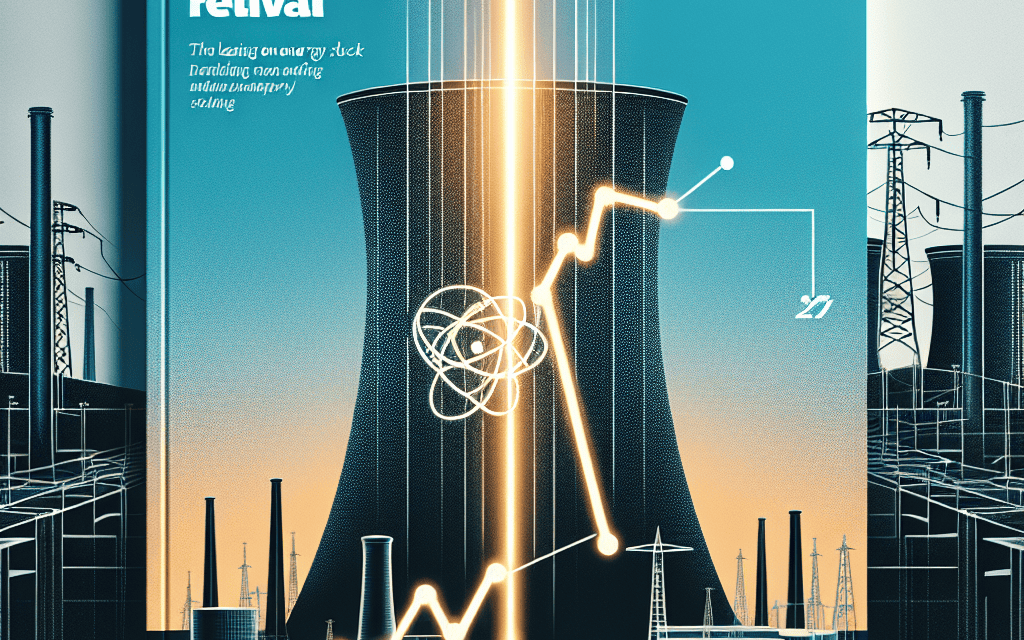“Navigating the Future: Addressing Hurdles in Nuclear Power’s Resurgence”
Introduction
The resurgence of interest in nuclear power as a viable solution to global energy challenges has brought to light a series of obstacles that leading energy stocks must navigate. As the world grapples with the urgent need to transition to cleaner energy sources, nuclear power is increasingly viewed as a critical component of a sustainable energy future. However, the path to revitalizing this sector is fraught with challenges, including regulatory hurdles, public perception issues, and the substantial financial investments required for the development and maintenance of nuclear facilities. These challenges are pivotal for energy companies aiming to capitalize on the potential of nuclear power, necessitating strategic planning and innovation to overcome barriers and drive growth in this promising yet complex arena.
Challenges Facing Nuclear Power Revival in the Energy Sector
The revival of nuclear power in the energy sector has been a topic of considerable debate and analysis, particularly as the world grapples with the dual challenges of meeting growing energy demands and reducing carbon emissions. A leading energy stock, which has been at the forefront of this discussion, has identified several challenges that must be addressed to facilitate a successful resurgence of nuclear power. These challenges are multifaceted, encompassing economic, regulatory, technological, and societal dimensions.
To begin with, the economic viability of nuclear power remains a significant hurdle. The initial capital investment required for constructing nuclear power plants is substantial, often running into billions of dollars. This financial burden is exacerbated by the long lead times associated with nuclear projects, which can span over a decade from planning to operation. Consequently, investors are often hesitant to commit to such long-term ventures, especially when alternative energy sources like wind and solar offer quicker returns on investment. Moreover, the cost of decommissioning old nuclear plants and managing nuclear waste adds another layer of financial complexity, further deterring investment in new nuclear projects.
In addition to economic challenges, regulatory hurdles also pose significant obstacles to the revival of nuclear power. The nuclear industry is subject to stringent regulations aimed at ensuring safety and environmental protection. While these regulations are essential, they can also lead to lengthy approval processes and increased costs. The complexity of navigating these regulatory frameworks can discourage new entrants and stifle innovation within the sector. Furthermore, the lack of a standardized global regulatory framework means that companies must adapt to varying regulations across different countries, complicating international collaboration and investment.
Technological challenges also play a crucial role in the nuclear power revival. While advancements in reactor design, such as small modular reactors (SMRs) and next-generation reactors, hold promise for safer and more efficient nuclear power, these technologies are still in the developmental stages. The transition from traditional large-scale reactors to these innovative designs requires significant research and development, as well as substantial financial investment. Additionally, the integration of nuclear power with other renewable energy sources to create a balanced and resilient energy grid presents further technical challenges that must be addressed.
Beyond economic, regulatory, and technological issues, societal acceptance of nuclear power is another critical factor influencing its revival. Public perception of nuclear energy is often shaped by historical incidents such as the Chernobyl and Fukushima disasters, leading to widespread apprehension about the safety of nuclear power. Overcoming this societal skepticism requires transparent communication about the safety measures in place and the potential benefits of nuclear energy in reducing carbon emissions and providing reliable power. Engaging with communities and stakeholders to build trust and understanding is essential for gaining public support.
In conclusion, while the potential for a nuclear power revival exists, it is contingent upon addressing a complex array of challenges. Economic considerations, regulatory frameworks, technological advancements, and societal acceptance all play pivotal roles in shaping the future of nuclear energy. As the leading energy stock has highlighted, a concerted effort involving governments, industry stakeholders, and the public is necessary to overcome these obstacles and harness the full potential of nuclear power in the global energy landscape.
Key Obstacles for Nuclear Power in the Modern Energy Market
In recent years, the global energy landscape has been undergoing a significant transformation, driven by the urgent need to address climate change and reduce carbon emissions. As countries strive to transition to cleaner energy sources, nuclear power has re-emerged as a potential solution due to its ability to generate large amounts of electricity with minimal greenhouse gas emissions. However, despite its potential benefits, the revival of nuclear power faces several key obstacles that must be addressed to ensure its viability in the modern energy market.
One of the primary challenges confronting the nuclear power industry is the high cost of construction and maintenance of nuclear power plants. Building a nuclear facility requires substantial capital investment, often running into billions of dollars. This financial burden is exacerbated by the lengthy construction timelines, which can span over a decade, leading to cost overruns and delays. Consequently, investors and governments are often hesitant to commit to such projects, especially when compared to the rapidly decreasing costs of renewable energy technologies like wind and solar power.
In addition to financial hurdles, nuclear power faces significant regulatory and safety challenges. The catastrophic accidents at Chernobyl and Fukushima have left a lasting impact on public perception, leading to heightened safety standards and rigorous regulatory frameworks. While these measures are essential for ensuring the safe operation of nuclear facilities, they also contribute to increased costs and extended timelines for plant approval and construction. Moreover, the disposal of nuclear waste remains a contentious issue, with no universally accepted solution for long-term storage. The potential environmental and health risks associated with nuclear waste further complicate the industry’s efforts to gain public trust and support.
Another obstacle is the aging infrastructure of existing nuclear power plants. Many of the world’s nuclear facilities were built several decades ago and are approaching the end of their operational lifespans. Upgrading or decommissioning these plants presents a significant challenge, both in terms of cost and technical complexity. The industry must also contend with a shortage of skilled labor, as the workforce that built and maintained these plants is retiring, and there is a lack of new talent entering the field. This skills gap poses a risk to the safe and efficient operation of nuclear facilities and underscores the need for investment in education and training programs to cultivate the next generation of nuclear engineers and technicians.
Furthermore, the competitive landscape of the energy market presents an additional challenge for nuclear power. The rapid advancement and deployment of renewable energy technologies have reshaped the market dynamics, with renewables becoming increasingly cost-competitive. This shift has led to a growing preference for renewable energy sources, which are perceived as more sustainable and environmentally friendly. As a result, nuclear power must demonstrate its value proposition in terms of reliability, baseload capacity, and low carbon emissions to remain relevant in the evolving energy mix.
In conclusion, while nuclear power holds promise as a low-carbon energy source, it faces a myriad of challenges that must be addressed to secure its place in the modern energy market. Overcoming financial, regulatory, and infrastructural obstacles, as well as addressing public perception and competition from renewables, will be crucial for the industry’s revival. As the world continues to seek sustainable energy solutions, the future of nuclear power will depend on its ability to adapt and innovate in response to these challenges.
Understanding the Hurdles in Nuclear Energy’s Comeback
The resurgence of interest in nuclear power as a viable solution to the world’s growing energy demands and climate change concerns has been met with both optimism and skepticism. As one of the leading energy stocks in the market, the company at the forefront of this revival has identified several challenges that must be addressed to ensure the successful reintegration of nuclear energy into the global energy mix. Understanding these hurdles is crucial for stakeholders, policymakers, and the public as they navigate the complexities of nuclear power’s comeback.
To begin with, the financial implications of developing new nuclear power plants are significant. The initial capital investment required for constructing a nuclear facility is substantially higher than that for renewable energy sources such as wind or solar. This financial burden is compounded by the lengthy construction timelines, which can span over a decade, leading to increased costs and potential delays. Consequently, securing funding and managing financial risks are paramount concerns for companies and governments looking to invest in nuclear energy.
Moreover, regulatory challenges present another formidable obstacle. The nuclear industry is subject to stringent safety and environmental regulations, which vary significantly across different countries. These regulations are essential for ensuring the safe operation of nuclear facilities, but they can also lead to bureaucratic delays and increased costs. Harmonizing international standards and streamlining regulatory processes could facilitate the development of nuclear power, yet achieving such alignment remains a complex task.
Public perception and acceptance of nuclear energy also play a critical role in its revival. The memory of past nuclear accidents, such as Chernobyl and Fukushima, continues to influence public opinion, often leading to resistance against new nuclear projects. Building public trust through transparent communication, education, and demonstration of advanced safety technologies is essential for overcoming this barrier. The development of next-generation reactors, which promise enhanced safety features and reduced waste, could help alleviate public concerns and garner broader support.
In addition to these challenges, the issue of nuclear waste management remains unresolved. The long-term storage and disposal of radioactive waste pose significant environmental and safety risks. While some countries have made progress in developing deep geological repositories, others are still grappling with finding suitable solutions. Advancements in waste recycling and reprocessing technologies offer potential pathways to mitigate these concerns, but widespread implementation is still in its nascent stages.
Furthermore, the integration of nuclear power into a rapidly evolving energy landscape presents its own set of challenges. The rise of renewable energy sources and advancements in energy storage technologies have transformed the energy sector, necessitating a reevaluation of nuclear power’s role. Balancing the intermittent nature of renewables with the steady output of nuclear energy requires innovative grid management solutions and policy frameworks that encourage collaboration between different energy sources.
In conclusion, while nuclear power holds promise as a low-carbon energy source capable of meeting global energy demands, its revival is fraught with challenges that must be carefully navigated. Addressing financial, regulatory, public perception, waste management, and integration issues is essential for the successful reintegration of nuclear energy into the global energy mix. As the leading energy stock continues to identify and tackle these hurdles, collaboration among industry stakeholders, governments, and the public will be crucial in shaping the future of nuclear power and its role in achieving a sustainable energy future.
Nuclear Power Revival: Identifying the Main Challenges

The revival of nuclear power as a viable energy source has been a topic of considerable debate among policymakers, environmentalists, and industry leaders. As the world grapples with the urgent need to transition to cleaner energy sources, nuclear power presents itself as a potential solution due to its ability to generate large amounts of electricity with minimal carbon emissions. However, despite its advantages, the path to revitalizing nuclear energy is fraught with significant challenges that must be addressed to ensure its successful integration into the global energy mix.
One of the foremost challenges in the nuclear power revival is the issue of public perception and safety concerns. The memories of past nuclear accidents, such as those at Chernobyl and Fukushima, continue to cast a long shadow over the industry. These incidents have instilled a deep-seated fear of nuclear energy in the public consciousness, making it difficult to garner widespread support for new projects. To overcome this hurdle, it is imperative for industry leaders and governments to engage in transparent communication, emphasizing the advancements in safety technology and the stringent regulatory frameworks that govern modern nuclear power plants.
In addition to public perception, the economic viability of nuclear power poses another significant challenge. The construction of nuclear power plants requires substantial capital investment, often running into billions of dollars. This financial burden is further exacerbated by lengthy construction timelines and the potential for cost overruns. Consequently, investors may be hesitant to commit to nuclear projects, especially when compared to the rapidly decreasing costs of renewable energy sources like wind and solar. To address this issue, innovative financing models and government incentives may be necessary to attract investment and make nuclear power a more competitive option.
Moreover, the management of nuclear waste remains a critical concern in the discussion of nuclear power revival. The long-lived radioactive waste generated by nuclear reactors poses a significant environmental and security risk if not properly managed. While advancements in waste storage and disposal technologies have been made, finding a permanent solution for nuclear waste remains elusive. Developing robust waste management strategies and securing public trust in these methods are essential steps in addressing this challenge.
Furthermore, the regulatory landscape for nuclear power is complex and often varies significantly between countries. Navigating this intricate web of regulations can be a daunting task for companies looking to invest in nuclear energy. Streamlining regulatory processes and fostering international collaboration could help mitigate these challenges, allowing for more efficient development and deployment of nuclear technologies.
Finally, the nuclear industry faces the challenge of an aging workforce and a potential skills gap. As many experienced professionals approach retirement, there is a pressing need to attract and train a new generation of workers equipped with the skills necessary to operate and maintain advanced nuclear technologies. Investing in education and training programs, as well as promoting careers in nuclear science and engineering, will be crucial in ensuring a sustainable workforce for the future of nuclear power.
In conclusion, while nuclear power holds promise as a key component of a low-carbon energy future, its revival is contingent upon addressing several formidable challenges. By tackling issues related to public perception, economic viability, waste management, regulatory complexity, and workforce development, the nuclear industry can pave the way for a safer, more sustainable energy landscape. As stakeholders work collaboratively to overcome these obstacles, the potential for nuclear power to contribute significantly to global energy needs becomes increasingly attainable.
The Role of Policy in Overcoming Nuclear Energy Challenges
The revival of nuclear power as a viable energy source has been a topic of considerable debate in recent years, particularly as the world grapples with the dual challenges of meeting growing energy demands and reducing carbon emissions. A leading energy stock, which has been at the forefront of this discussion, has identified several challenges that must be addressed to facilitate the resurgence of nuclear energy. Central to overcoming these challenges is the role of policy, which can either act as a catalyst for progress or a barrier to development.
To begin with, one of the primary challenges facing the nuclear power industry is the high cost of construction and maintenance of nuclear facilities. These costs are often prohibitive, deterring investment and slowing the pace of development. However, policy interventions can play a crucial role in mitigating these financial burdens. For instance, government subsidies and tax incentives can lower the initial capital required for nuclear projects, making them more attractive to investors. Additionally, streamlined regulatory processes can reduce the time and expense associated with obtaining necessary approvals, further enhancing the financial viability of nuclear energy projects.
Moreover, public perception and acceptance of nuclear power remain significant hurdles. Historical incidents, such as the Chernobyl and Fukushima disasters, have left a lasting impact on public opinion, leading to widespread skepticism and resistance. Here, policy can serve as a powerful tool in reshaping public perception. By investing in public education campaigns and promoting transparency in nuclear operations, governments can help build trust and confidence in the safety and reliability of nuclear energy. Furthermore, policies that emphasize stringent safety standards and robust emergency preparedness plans can reassure the public that the risks associated with nuclear power are being effectively managed.
In addition to financial and perceptual challenges, the nuclear industry also faces technical and logistical obstacles. The development of advanced nuclear technologies, such as small modular reactors (SMRs) and next-generation reactors, holds promise for addressing some of these issues. However, significant research and development efforts are required to bring these technologies to fruition. Policy support in the form of research grants and collaborative initiatives can accelerate technological advancements and facilitate the deployment of innovative nuclear solutions. By fostering partnerships between government agencies, academic institutions, and private companies, policies can create an ecosystem conducive to innovation and progress in the nuclear sector.
Furthermore, the issue of nuclear waste management remains a critical concern. The long-term storage and disposal of radioactive waste pose environmental and safety challenges that must be addressed to ensure the sustainability of nuclear power. Policy frameworks that prioritize the development of safe and effective waste management solutions are essential. This includes investing in research to explore new methods of waste reduction and disposal, as well as establishing clear guidelines and regulations for waste handling and storage.
In conclusion, while the challenges facing the revival of nuclear power are multifaceted, the role of policy in overcoming these obstacles cannot be overstated. By addressing financial, perceptual, technical, and waste management issues through targeted policy interventions, governments can pave the way for a sustainable and secure nuclear energy future. As the world continues to seek solutions to its energy and environmental challenges, the strategic implementation of supportive policies will be instrumental in unlocking the potential of nuclear power as a key component of the global energy mix.
Technological Barriers to Nuclear Power’s Resurgence
The resurgence of nuclear power as a viable energy source has been a topic of considerable debate in recent years, particularly as the world grapples with the dual challenges of climate change and energy security. A leading energy stock, renowned for its investments in nuclear technology, has identified several technological barriers that must be addressed to facilitate the revival of nuclear power. These challenges are not only technical but also involve regulatory and economic dimensions, which together form a complex web that must be navigated to achieve a sustainable nuclear future.
One of the primary technological barriers is the aging infrastructure of existing nuclear power plants. Many of these facilities were constructed decades ago and are nearing the end of their operational lifespans. Upgrading or replacing these plants with modern reactors is a costly and time-consuming endeavor. Moreover, the development of new reactor designs, such as small modular reactors (SMRs), while promising, still faces significant hurdles in terms of licensing and commercial deployment. The energy stock emphasizes that overcoming these challenges requires substantial investment in research and development to ensure that new technologies are both safe and economically viable.
In addition to infrastructure concerns, the issue of nuclear waste management remains a significant obstacle. The long-term storage and disposal of radioactive waste have yet to be resolved satisfactorily, with many proposed solutions facing public opposition and regulatory hurdles. The energy stock highlights that advancements in waste recycling and reprocessing technologies could mitigate some of these concerns, but these technologies are still in the developmental stages and require further refinement and acceptance.
Furthermore, the integration of nuclear power into the modern energy grid presents another set of challenges. As renewable energy sources like wind and solar become more prevalent, the energy grid must adapt to accommodate these intermittent sources alongside nuclear power. This necessitates advancements in grid technology and energy storage solutions to ensure a stable and reliable energy supply. The energy stock points out that collaboration between nuclear and renewable sectors could lead to innovative solutions that enhance grid resilience and efficiency.
Another critical factor is the regulatory environment surrounding nuclear power. The stringent safety standards and lengthy approval processes, while essential for ensuring public safety, can also impede the rapid deployment of new nuclear technologies. The energy stock suggests that streamlining regulatory processes, without compromising safety, could accelerate the adoption of advanced nuclear reactors. This requires a delicate balance between maintaining rigorous safety protocols and fostering an environment conducive to innovation and growth.
Economic considerations also play a pivotal role in the revival of nuclear power. The high initial costs associated with building nuclear plants, coupled with the long lead times for construction, can deter investment. The energy stock advocates for policy measures that provide financial incentives and risk-sharing mechanisms to attract private investment in nuclear projects. Such measures could include government-backed loan guarantees, tax incentives, and public-private partnerships.
In conclusion, while the potential for a nuclear power resurgence is significant, the path forward is fraught with technological, regulatory, and economic challenges. Addressing these barriers requires a concerted effort from industry stakeholders, policymakers, and the scientific community. By fostering innovation, streamlining regulations, and creating favorable economic conditions, the energy sector can pave the way for a sustainable and secure nuclear future. The insights provided by the leading energy stock underscore the importance of a holistic approach to overcoming these challenges and realizing the full potential of nuclear power in the global energy landscape.
Economic Factors Impacting Nuclear Power’s Revival
The revival of nuclear power as a viable energy source has been a topic of considerable debate in recent years, particularly as the world grapples with the dual challenges of meeting rising energy demands and reducing carbon emissions. A leading energy stock, which has been at the forefront of this discussion, has identified several economic factors that are impacting the resurgence of nuclear power. These factors are multifaceted, intertwining with technological, regulatory, and market dynamics, and they collectively shape the landscape in which nuclear energy must operate.
To begin with, the high initial capital costs associated with constructing nuclear power plants present a significant economic hurdle. Unlike renewable energy sources such as wind and solar, which have seen dramatic reductions in costs due to technological advancements and economies of scale, nuclear power plants require substantial upfront investment. This financial burden is exacerbated by the lengthy construction timelines, often spanning a decade or more, which can deter investors seeking quicker returns. Consequently, the financial risk associated with nuclear projects is a critical factor that influences investment decisions and, by extension, the pace of nuclear power’s revival.
Moreover, the regulatory environment plays a pivotal role in shaping the economic viability of nuclear energy. Stringent safety standards and regulatory requirements, while essential for ensuring the safe operation of nuclear facilities, can lead to increased costs and extended project timelines. These regulatory hurdles can also create uncertainty, which further complicates the financial planning and risk assessment processes for potential investors. In this context, the energy stock highlights the need for a balanced regulatory framework that maintains safety without stifling innovation and investment.
In addition to these challenges, the competitive landscape of the energy market also impacts the economic prospects of nuclear power. The rapid growth of renewable energy sources, driven by technological advancements and favorable policy incentives, has intensified competition in the energy sector. As renewables become increasingly cost-competitive, nuclear power must demonstrate not only its environmental benefits but also its economic feasibility. This competitive pressure necessitates continuous innovation in nuclear technology, such as the development of small modular reactors, which promise to reduce costs and construction times.
Furthermore, public perception and societal acceptance of nuclear power significantly influence its economic revival. Historical incidents and concerns about nuclear waste management have contributed to a cautious public attitude towards nuclear energy. This societal skepticism can translate into political resistance, affecting policy decisions and, ultimately, the economic environment for nuclear power. Therefore, addressing public concerns through transparent communication and demonstrating the safety and reliability of modern nuclear technology are crucial for gaining societal support and facilitating economic investment.
In conclusion, the revival of nuclear power is contingent upon navigating a complex web of economic factors. High capital costs, regulatory challenges, competitive market dynamics, and public perception all play integral roles in shaping the future of nuclear energy. As the leading energy stock underscores, a concerted effort involving technological innovation, regulatory reform, and public engagement is essential to overcoming these challenges. By addressing these economic factors, nuclear power can potentially reclaim its position as a key component of a sustainable and diversified energy portfolio, contributing to global efforts to combat climate change and ensure energy security.
Q&A
1. **Question:** What are the primary challenges facing the revival of nuclear power?
**Answer:** The primary challenges include high construction costs, regulatory hurdles, public perception and safety concerns, waste management, and competition from cheaper renewable energy sources.
2. **Question:** How do high construction costs impact nuclear power projects?
**Answer:** High construction costs make nuclear power projects financially risky and less attractive to investors, leading to delays and cancellations.
3. **Question:** What role do regulatory hurdles play in the nuclear power industry?
**Answer:** Regulatory hurdles can lead to lengthy approval processes, increased costs, and uncertainty, discouraging investment in new nuclear projects.
4. **Question:** Why is public perception a challenge for nuclear power?
**Answer:** Public perception is often influenced by past nuclear accidents, leading to safety concerns and opposition to new nuclear projects.
5. **Question:** How is waste management a challenge for nuclear power?
**Answer:** The long-term storage and disposal of radioactive waste remain unresolved issues, posing environmental and safety challenges.
6. **Question:** In what ways does competition from renewable energy sources affect nuclear power?
**Answer:** Renewable energy sources like wind and solar have become cheaper and more scalable, making them more attractive alternatives to nuclear power.
7. **Question:** What strategies are being considered to overcome these challenges in nuclear power?
**Answer:** Strategies include developing advanced reactor designs, improving regulatory frameworks, enhancing public engagement, and investing in research for better waste management solutions.
Conclusion
The revival of nuclear power as a leading energy source faces several significant challenges. These include high initial capital costs, long construction timelines, regulatory hurdles, and public perception issues related to safety and waste management. Additionally, the competition from cheaper renewable energy sources and advancements in energy storage technologies further complicates the nuclear sector’s resurgence. To overcome these obstacles, the industry must focus on technological innovations, such as small modular reactors, and work towards improving regulatory frameworks and public engagement strategies. Addressing these challenges is crucial for nuclear power to play a substantial role in the future energy mix and contribute to global decarbonization efforts.





